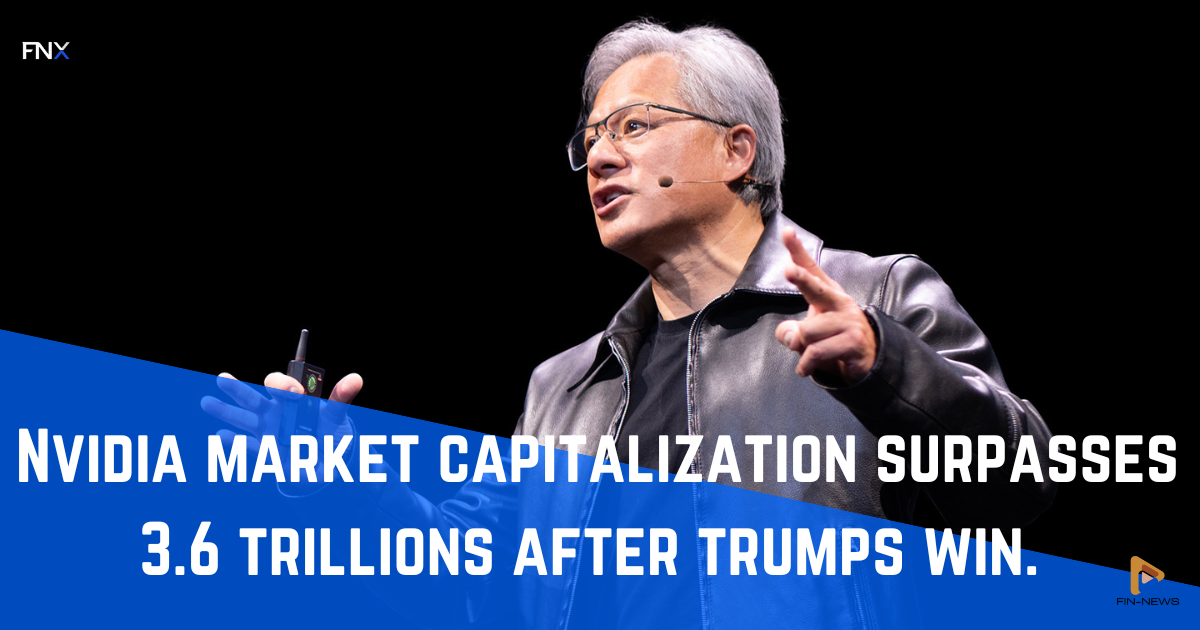
In a historic milestone for the tech industry, NVIDIA Corporation, the world-renowned AI and semiconductor giant, has surpassed a staggering $3.6 trillion in market capitalization. This remarkable achievement follows the surprising outcome of the U.S. presidential election, in which former President Donald Trump secured a second non-consecutive term, marking a significant shift in market expectations and investor sentiment across sectors.
Wall Street Reacts to Trump’s Re-Election
Trump’s return to the White House has fueled speculation that his administration may prioritize deregulation, corporate tax cuts, and renewed trade negotiations—all factors that have previously boosted tech stocks. The stock market reacted strongly in the hours following the election announcement, with NVIDIA leading the charge. Known for its dominance in graphics processing units (GPUs) and cutting-edge artificial intelligence (AI) technology, NVIDIA has benefited immensely from increased demand across sectors from gaming to AI research to cloud computing.
The S&P 500 saw substantial gains, closing up 3% the day after the election, while NVIDIA shares surged over 12% in early trading, ultimately propelling the company to a valuation of over $3.6 trillion. The market’s confidence appears rooted in expectations that Trump’s economic policies will favor capital investments in high-growth sectors, including artificial intelligence, autonomous driving, and next-gen semiconductors—all key focus areas for NVIDIA.
NVIDIA’s Path to Trillions
NVIDIA’s rise to this new valuation threshold underscores its meteoric growth trajectory in the last decade. Initially known primarily for its role in powering gaming PCs with high-performance GPUs, the company quickly pivoted into artificial intelligence and machine learning—a strategic move that has paid massive dividends.
Over the years, NVIDIA’s GPUs have become critical infrastructure for deep learning, making them indispensable in fields such as autonomous vehicles, healthcare diagnostics, robotics, and even financial modeling. With the advent of generative AI and large language models, demand for NVIDIA’s latest GPUs, like the H100 and A100, has skyrocketed. Major corporations and tech startups alike have been investing heavily in NVIDIA-powered infrastructure, establishing the company as the backbone of the burgeoning AI revolution.
What Trump’s Win Means for Tech Giants Like NVIDIA
Trump’s return to office has stirred hopes for a business-friendly environment, particularly within the tech sector. Analysts believe that a combination of favorable tax policies and relaxed regulatory oversight could spur further investment in artificial intelligence, robotics, and high-performance computing. The possibility of increased federal funding for AI research and cybersecurity initiatives could also offer NVIDIA opportunities to expand its footprint in defense and national security, areas where its technology is becoming increasingly relevant.
However, Trump’s previous administration was known for its strict stance on trade with China, leading some analysts to caution that renewed tariffs or export controls could pose risks for tech companies with significant exposure to Asian markets. Despite these uncertainties, NVIDIA’s expansive R&D efforts and its diversification across various high-growth sectors appear to make it well-positioned to navigate potential challenges.
Investor Outlook: AI and Semiconductor Demand Remain Key
Investors are betting big on NVIDIA’s continued growth, as AI applications proliferate across industries. According to Goldman Sachs, AI’s contribution to global GDP is projected to increase significantly by 2030, with NVIDIA’s GPUs and related products likely to remain at the forefront of this growth. Demand for semiconductor hardware is expected to rise dramatically as AI and machine learning algorithms require more sophisticated computing power.
In addition, NVIDIA’s strategic expansion into cloud partnerships with giants like Microsoft and Google has positioned it to benefit from the surge in cloud-based AI services. Cloud providers rely on NVIDIA’s GPUs to support scalable AI solutions, driving additional revenue streams for the company.
Competitors Scramble to Keep Pace
The AI hardware space has become increasingly competitive, with companies like AMD, Intel, and emerging firms in China and the U.S. racing to develop alternative solutions. Yet, NVIDIA’s commanding position in both hardware and its growing ecosystem of software solutions (such as CUDA and NVIDIA AI) provides it with a competitive edge that rivals have struggled to match.
As the demand for AI solutions shows no signs of slowing, analysts expect NVIDIA’s upward trajectory to continue, albeit with some possible volatility as the global regulatory and economic environment evolves.
Industry Reactions and Broader Implications
Following Trump’s election, numerous industry experts have weighed in on what his administration might mean for the tech sector. Jensen Huang, NVIDIA’s CEO, acknowledged the election outcome and emphasized the company’s commitment to "accelerating the AI-powered world and supporting innovation that addresses society’s greatest challenges."
Conclusion
With its market cap now exceeding $3.6 trillion, NVIDIA’s historic achievement marks a defining moment in the evolution of the tech industry. As AI and high-performance computing technologies transform nearly every sector, NVIDIA is well-poised to benefit from both technological and political tailwinds. However, with Trump’s re-election introducing new dynamics into trade policy and tech regulation, NVIDIA’s journey forward may be shaped as much by geopolitical factors as by technological advancements.
As markets continue to react to Trump’s win, the next few months will be critical for assessing the long-term impact of this administration’s policies on the tech sector and its high-profile players. For NVIDIA, a leader in AI and computing power, the future looks promising yet fraught with potential challenges, as it aims to sustain its rapid growth and pioneering status in an increasingly competitive market.

Leave a comment
Your email address will not be published. Required fields are marked *